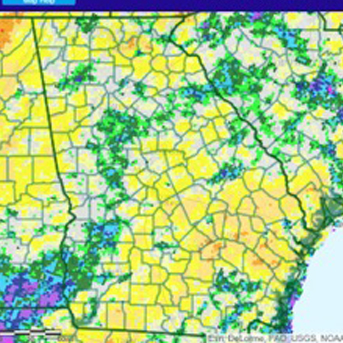Despite Georgians’ constant umbrella use of late, most of September 2015 was actually drier than normal.
Most areas of Georgia reported less-than-normal precipitation, except those in the far southeast of the state. The precipitation was scarce early in September, but rain was more plentiful during the last week, which resulted in a reduction in drought.
Those early-September dry conditions increased pest pressure on some crops, but allowed for the reaping of corn and other crops. Increased rain at the end of the month reduced drought levels, but caused problems for farmers who wanted to harvest peanuts and other crops. The rain improved forage conditions for livestock producers.
The highest monthly precipitation total reported by a National Weather Service station was recorded in Brunswick, Georgia, as 8.84 inches, 3.08 inches above normal. The lowest monthly precipitation total was recorded in Columbus, Georgia, as 1.92 inches, 1.14 inches below normal. Atlanta received 3.93 inches of precipitation, 0.54 inches below normal; Athens, Georgia, received 3.48 inches, 0.46-inch below normal; Macon, Georgia, received 2.09 inches, 1.50 inches below normal; Savannah, Georgia, received 2.89 inches, 1.69 inches below normal; Augusta, Georgia, received 4.05 inches, 0.83-inch above normal; Alma, Georgia, received 5.02 inches, 1.38 inches above normal; Albany, Georgia, received 3.87 inches, 0.43-inch above normal; Rome, Georgia, received 3.03 inches, 0.38-inch below normal; and Valdosta, Georgia, received 3.21 inches, 1.43 inches below normal.
The highest single-day rainfall recorded by a Community Collaborative Rain, Hail and Snow (CoCoRaHS) Network volunteer was 3.41 inches near St. Marys in Camden County, Georgia, on Sept. 17, followed by 3.23 inches near Fayetteville, Georgia, on Sept. 11. The highest monthly rainfall recorded by CoCoRaHS volunteers was 11.19 inches, observed near St. Simons in Glynn County, Georgia.
September was slightly cooler than normal. Areas in the southwest corner of the state registered average temperatures about 3 degrees below normal, while the southeastern and northwestern corners saw average temperatures 1 to 2 degrees above normal.
In Atlanta, the monthly average temperature was 73.5 degrees Fahrenheit, on target with average temperatures; in Athens, Georgia, the average temperature was 73.3 F, on target with average temperatures; in Columbus, Georgia, 75.5 F, 1.1 degrees below normal; in Macon, Georgia, 74.5 F, 0.5-degree below normal; in Savannah, Georgia, 77.2 F, 0.3-degree above normal; in Brunswick, Georgia, 77.6 F, 0.5-degree below normal; in Alma, Georgia, 76.9 F, 0.2-degree below normal; in Augusta, Georgia, 75.3 F, 0.7-degree above normal; in Albany, Georgia, 77.5 F, 0.2-degree below normal; in Rome, Georgia, 73.1 F, 1.1 degrees above normal; and in Valdosta, Georgia, 77.5 F, 0.1-degree above normal.
Two temperature records were broken in September. The cities of Macon and Alma set new record lows of 49 F and 54 F, respectively, on Sept. 14, breaking the old records of 51 F and 55 F, set in 1996.
For more information, see the Climate and Agriculture in the SouthEast (CASE) blog at blog.extension.uga.edu/climate/ or visit the new website at gaclimate.org. Email your weather and climate impacts on agriculture to share on the blog to Pam Knox at pknox@uga.edu.








